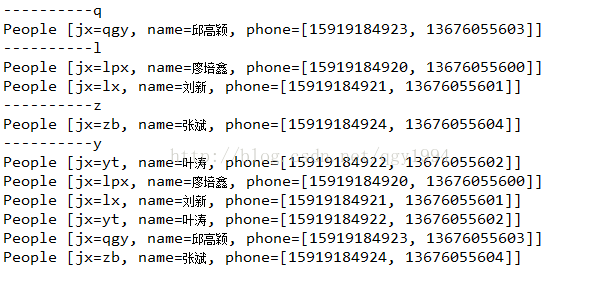通讯录打开后,触屏到某个字母开头的姓就能很方便快捷地找到联系人。所以如何知道姓名开头字母呢,这里我用了一个获取中文的拼音包。
从测试类开始吧:
import java.util.*;
public class Test {
List<People> phoneBook =new ArrayList<People>();
//测试
public static void main(String[] args) {
Test t=new Test();
t.init();
t.sortPeople();
t.print();
}
//方法三:排序处理
private void sortPeople(){
Set<String> first=new HashSet<String>();
for( People p : phoneBook) {
first.add(""+p.getJx().charAt(0));
}
for (String c : first) {
System.out.println("----------"+c);
for( People p : phoneBook) {
if(c.equals(""+p.getJx().charAt(0))){
System.out.println(p);
}
}
}
}
//方法二: 输出
private void print(){
for (People p : phoneBook) {
System.out.println(p);
}
}
//方法一:准备
private void init() {
String names[]={"廖培鑫","刘新","叶涛","邱高颖","张斌"}; //存到文本中
People p=null;
for (int i = 0; i < names.length; i++) {
p=new People();
p.setName(names[i]);
p.setJx(GetPinyin.getPinYinHeadChar(names[i]));
//号码
ArrayList<String> phone=new ArrayList<String>();
phone.add("1591918492"+i);
phone.add("1367605560"+i);
p.setPhone(phone);
phoneBook.add(p);
}
}
}
所用到拼音工具的类:
package pinyin;
import net.sourceforge.pinyin4j.PinyinHelper;
import net.sourceforge.pinyin4j.format.HanyuPinyinCaseType;
import net.sourceforge.pinyin4j.format.HanyuPinyinOutputFormat;
import net.sourceforge.pinyin4j.format.HanyuPinyinToneType;
import net.sourceforge.pinyin4j.format.HanyuPinyinVCharType;
import net.sourceforge.pinyin4j.format.exception.BadHanyuPinyinOutputFormatCombination;
public class GetPinyin {
/**
* 得到 全拼
* @param src
* @return
*/
public static String getPingYin(String src) {
char[] t1 = null;
t1 = src.toCharArray();
String[] t2 = new String[t1.length];
HanyuPinyinOutputFormat t3 = new HanyuPinyinOutputFormat();
t3.setCaseType(HanyuPinyinCaseType.LOWERCASE);
t3.setToneType(HanyuPinyinToneType.WITHOUT_TONE);
t3.setVCharType(HanyuPinyinVCharType.WITH_V);
String t4 = "";
int t0 = t1.length;
try {
for (int i = 0; i < t0; i++) {
// 判断是否为汉字字符
if (java.lang.Character.toString(t1[i]).matches("[\\u4E00-\\u9FA5]+")) {
t2 = PinyinHelper.toHanyuPinyinStringArray(t1[i], t3);
t4 += t2[0];
} else {
t4 += java.lang.Character.toString(t1[i]);
}
}
return t4;
} catch (BadHanyuPinyinOutputFormatCombination e1) {
e1.printStackTrace();t4 = "#";
}
return t4;
}
/**
* 得到中文首字母
*
* @param str
* @return
*/
public static String getPinYinHeadChar(String str) {
String convert = "";
for (int j = 0; j < str.length(); j++) {
char word = str.charAt(j);
String[] pinyinArray = PinyinHelper.toHanyuPinyinStringArray(word);
if (pinyinArray != null) {
convert += pinyinArray[0].charAt(0);
} else {
convert += word;
}
}
return convert;
}
/**
* 将字符串转移为ASCII码
*
* @param cnStr
* @return
*/
public static String getCnASCII(String cnStr) {
StringBuffer strBuf = new StringBuffer();
byte[] bGBK = cnStr.getBytes();
for (int i = 0; i < bGBK.length; i++) {
// System.out.println(Integer.toHexString(bGBK[i]&0xff));
strBuf.append(Integer.toHexString(bGBK[i] & 0xff));
}
return strBuf.toString();
}
public static void main(String[] args) {
String cnStr = "邱高颖";
System.out.println(getPingYin(cnStr));
System.out.println(getPinYinHeadChar(cnStr));
}
}所用到的Bean :
package pinyin;
import java.util.ArrayList;
/**
* 联系人
* @author 小高
*/
public class People {
private String jx; //拼音简写
private String name; //联系人
private ArrayList<String> phone; //一个联系人可能有多个号码
public People(String jx, String name, ArrayList<String> phone) {
super();
this.jx = jx;
this.name = name;
this.phone = phone;
}
public People() {
super();
}
public String getJx() {
return jx;
}
public void setJx(String jx) {
this.jx = jx;
}
public String getName() {
return name;
}
public void setName(String name) {
this.name = name;
}
public ArrayList<String> getPhone() {
return phone;
}
public void setPhone(ArrayList<String> phone) {
this.phone = phone;
}
@Override
public String toString() {
return "People [jx=" + jx + ", name=" + name + ", phone=" + phone + "]";
}
}运行效果:


























 1403
1403

 被折叠的 条评论
为什么被折叠?
被折叠的 条评论
为什么被折叠?








